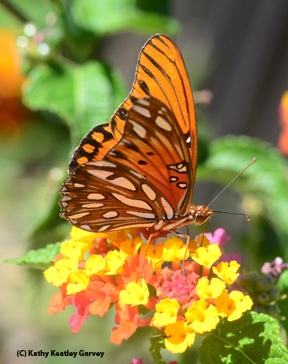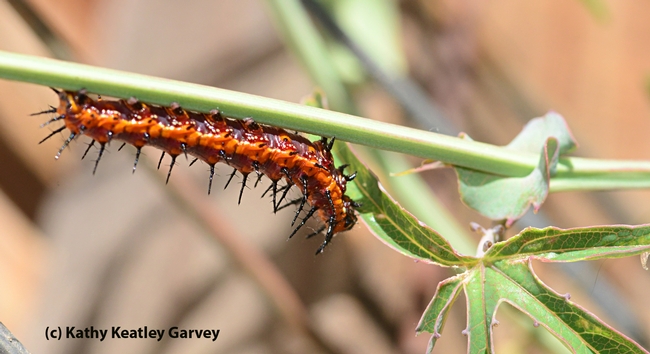
No doubt many of them did.
The award-winning book, published in 1969, traces the complete metamorphosis of a butterfly, from an egg to a larva (caterpillar) to a pupa (chrsyalis) to an adult.
If you've ever seen a Gulf Fritillary caterpillar chowing down on the leaves of a passion flower vine, you've seen The Very Hungry Caterpillar in action.
We planted a passion flower vine two months ago in our yard. The plant hasn't yet bloomed, but the Gulf Fritillary (Agraulis vanilla) found it. Thankfully! We planted it for them.
Within what seemed like a matter of days, the passion flower vine (the host plant of the Gulf Frits), went from no caterpillars--zero, zilch, nada--to five.
We've seen the showy orange-reddish butterflies fluttering around the plant looking for places to lay their eggs, but haven't seen them actually do it.
But the evidence is there!
"As a spiny orange-and-black caterpillar, it feeds only on passion flower leaves, eating many but not all species of the genus Passiflora," says butterfly expert Art Shapiro, distinguished professor of evolution and ecology at UC Davis. "There are no native members of this genus in the state of California, but several are widely cultivated in gardens."
The butterfly, he says, can breed where there is a "critical mass" of these plants in a town or neighborhood.
Let there be a critical mass!
Attached Images:

Gulf Fritillary (Agraulis vanilla) heads for a tasty leaf on a passion flower vine. (Photo by Kathy Keatley Garvey)

Two Gulf Fritillary caterpillars chowing down on the leaves of a passion flower vine. (Photo by Kathy Keatley Garvey)

Close-up of a very hungry caterpillar eating its fill. (Photo by Kathy Keatley Garvey)